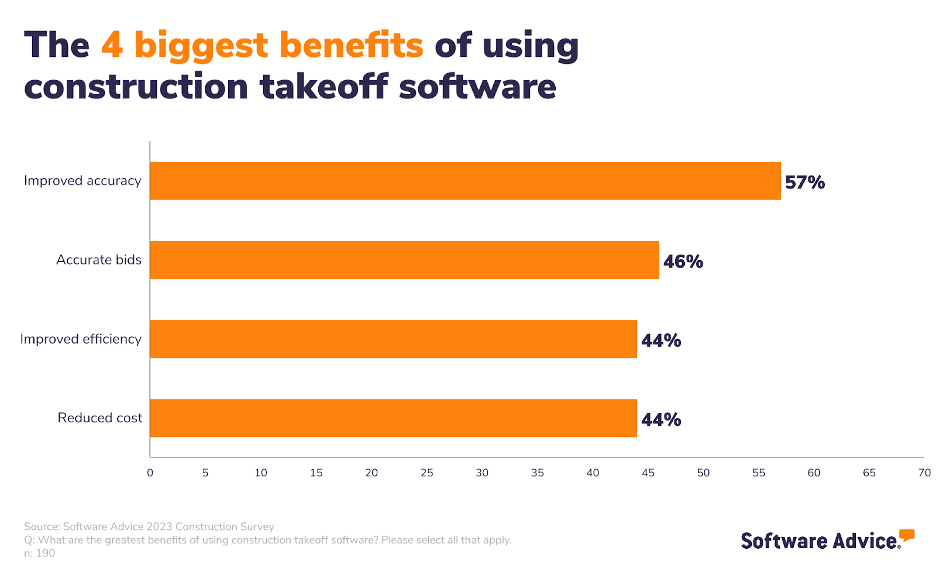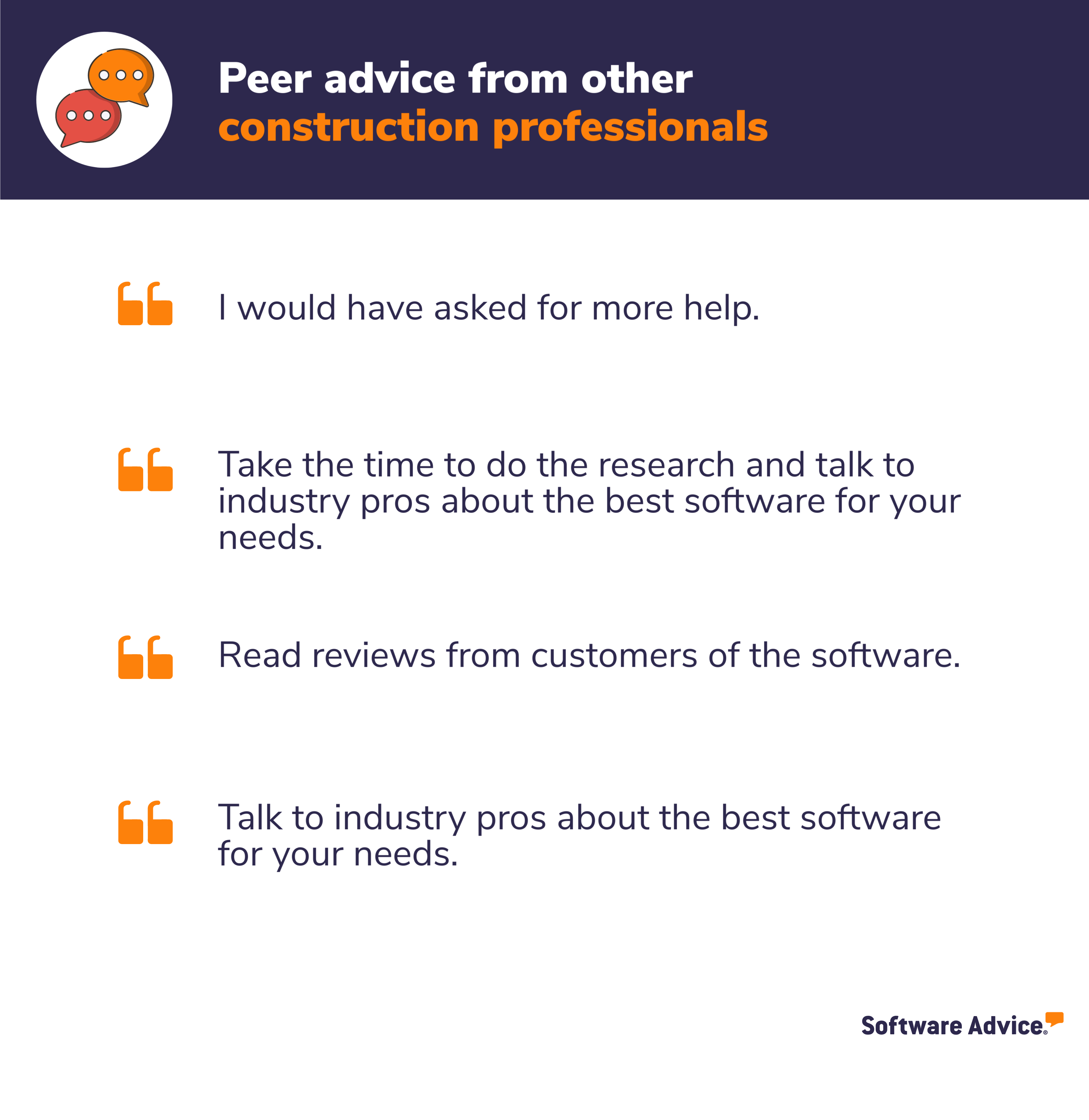Lessons Learned From Construction Owners About Software Selection
It can be hard to know the right time to invest in software for your business, especially if you don’t think the return on investment can justify the cost.
If you’re a small construction business owner who is buying software for the first time, and you want to understand what you need to consider so you can find the best software for your business, you’ve come to the right place.
The last thing you want to do is be one of the 61% of business leaders who regret a software purchase by learning what their industry peers would have done differently.
In order to bring you the best possible strategies you can implement to find the perfect software solution for your business, we analyzed 300 responses from a Software Advice survey of construction professionals who were involved in the software purchase process at their firm within the last six months.*
To gain more insights, we also talked to Niko Bernardone, one of our Software Advisor managers who has spoken to and helped hundreds of construction professionals find the right software.
1. Focus your research efforts on specific pain points
When you’re considering software, the first thing you need to do is determine what pain points you need the software to solve.
For instance, if you find yourself unable to provide quotes to potential customers in a timely fashion, you might be losing out on revenue. Additionally, you might find that the quotes you’re giving out aren’t accurate.
Generally, as a business owner, you will need to figure out what part of your business is lacking automation; ask yourself what part do you spend the most time on? If it’s scheduling, invest and focus on software suites with more robust scheduling features. During your work day, take notice of what parts of your job (that aren’t the actual manual labor) are taking the most time. Is it figuring out how to manage your project schedule? Calculating your quotes? Measuring the takeoff for your construction plans? That’s how you’ll figure out what you need your software to solve.
According to Niko Bernardone, for small construction companies that usually means moving away from Quickbooks or manual methods and toward specific takeoff software or estimating software.
Estimating software helps you provide estimates more quickly and accurately than doing it manually
If you’re providing estimates manually, you’re having to search through different prices in order to find the best one and plug those numbers into your estimate. If you’re using something basic such as Microsoft Word, you then have to worry about formatting to make it look professional. It’s time-consuming, and, if the customer doesn’t choose to work with you, it’s wasted time.
With estimating software, you can take the quantities of materials you’ll be using for your project and formulate how much money they will cost as well as calculate how much labor will be. What might have taken you hours to put together will instead take minutes. Some estimating software can even scan material costs from a large database from your area. You provide the system with a zip code or geographical location, and it will provide you with the best price options.
This not only saves you time, but it ensures you’re able to provide an accurate estimate as quickly as possible which will net you more work and happier clients. If you want a more complete breakdown of construction estimating software, take a look at our buyers guide.
Takeoff software helps you make a detailed construction plan more easily
Depending on the quantity of projects you’re completing or amount of estimates you’re providing, you might not need the added efficiency takeoff software provides. But if you find yourself overwhelmed and unable to keep up with the demand for your services, takeoff software will help you provide more complete, detailed construction plans with way less effort.
Takeoff software allows contractors to measure construction plans (e.g., blueprints and drawings) electronically instead of the conventional method of using pencils and rulers. Most systems will support the on-screen takeoff method, or the use of a digitizer pen.
According to our Software Advice 2023 Construction Survey*, the biggest benefits that construction professionals gained from using takeoff software include improved accuracy, more accurate bids, improved productivity and efficiency, and reduced costs.

For more information about takeoff software, read Construction Takeoff Essentials and Tips for Small Firms or our takeoff software buyers guide.
Takeoff and estimating software aren’t the only two software options for construction businesses. Plenty of other construction software options exist out there that will integrate with project scheduling, project management, or even accounting software as well. It all comes back to knowing what issues you need your software to solve in order to find the best software solution for your business.

2. Try multiple free trials and demos
One thing that we heard repeatedly from the business owners we surveyed is to try out the software before you buy it. Here’s a list of recommendations and best practices that have come from business owners as well as from Niko’s experience talking with business owners.
Have a backup plan if your first choice doesn’t have a free trial: Free trials aren’t always available for every software, so it’s important to have a game plan if your top choice doesn’t let you take it for a test drive before purchasing it. If your favorite options don’t have free trials, you can almost always get a hands-on demonstration with the software before making any decisions.
Utilize free trials with intention: Use the free trial exclusively during your next job to see if it helps alleviate the pain points you need it to. Write down any questions you might have so that you can ask the vendor about them. With a free trial, you’ll be much more informed and equipped to go into a demonstration with a vendor to maximize the information you get.
Provide the vendor with specific use cases: Think through what makes your job inefficient and provide a specific, real-world example that you’ve come across during a job so that the vendor can show you exactly how their software can help solve that issue.
Example
“I’m spending hours manually looking up material costs on a dozen different websites. How can your software help streamline that process? How can I be sure it’s accurate?”
Have multiple demonstrations before you make your final decision: The first can just be you and the vendor, but consider bringing in other stakeholders who will also be using the software for the second demo. They might have different questions or concerns that you hadn’t considered before.

For a more complete breakdown of how to prepare for software demos with vendors or choose software, check out these resources:
3. Ask for help from industry experts and peers
You’re not alone when it comes to searching for software. Even if you start from ground zero, so many resources are available to help you out. The first place you can start is asking your colleagues what software they use. Word of mouth remains king when it comes to finding solutions that might work for your business. After all, if you’re a roofer, and your colleagues who are also roofers love the software they use, it’s worth checking out.
Niko Bernardone
Manager at Software Advice
At Software Advice, we try to be the one-stop shop for nearly all of your research needs. Whether that’s our blog where we’ve written helpful articles about purchasing software, the master list of software options available to you broken up by category, our list of Frontrunners that breaks down the top options in each category, or the millions of user reviews to sort through, our aim is to equip you with all the information and tools you need to make the best possible decision; and it’s all free.
But the most useful resource we have is our advisors. Regardless of what stage of the buying process you’re in, our advisors can help you narrow down your list in order to help you find the best software option for your business.

If you’re curious about what our advisors are and how they can help you, check out these resources:
You’re not alone when it comes to purchasing software
Don’t tackle software selection alone. Listen to the advice from your peers who have gone through the same struggles. Ask for help. Read reviews. Talk to vendors. Try out multiple options.
It can seem daunting whenever you first start the search, but as long as you utilize the resources available to you, you will almost certainly be in a better position once you’ve acquired software. Operationally, you’ll be more efficient, you’ll be able to provide more accurate quotes in a quicker time frame, you’ll spend less time worrying about takeoff or estimating, and your project management will be more smooth.
Connecting with our team of advisors, especially at the very beginning of your software search, should be a no-brainer. We’ve helped hundreds of thousands of business leaders find the right match for their business, and there’s no downside.
A 15-minute chat can be the difference between spending too much on software because you don’t have a handle on the different pricing structures or jargon that vendors use to make selling their products easier.
Schedule a call or click here to chat with a software advisor now.
Survey methodology
* Software Advice’s 2023 Construction Feedback Survey was conducted in January 2023 among 301 U.S. respondents to learn more about construction software and its benefits. Respondents who were screened were construction professionals that were involved in the selection and purchase of construction software.